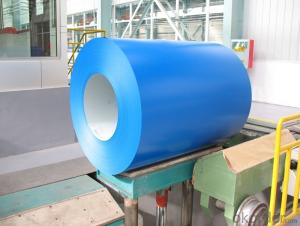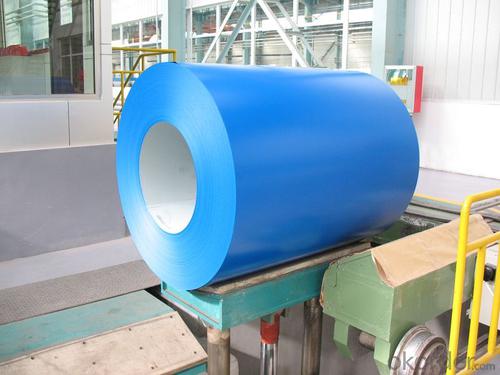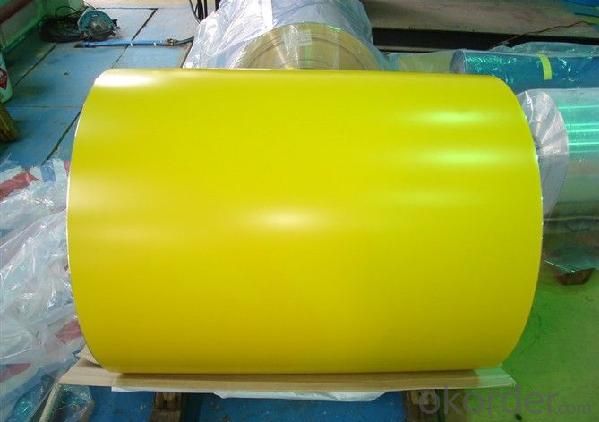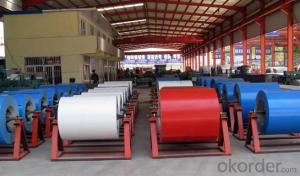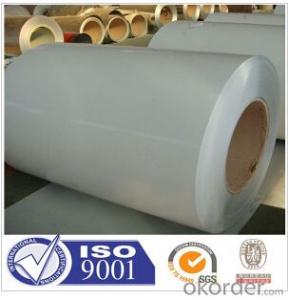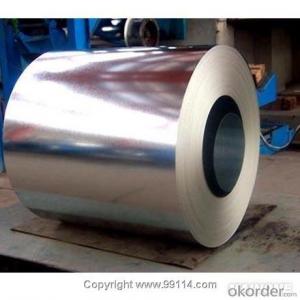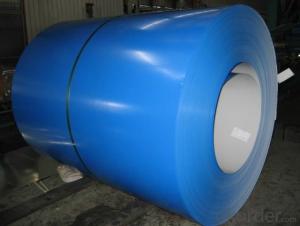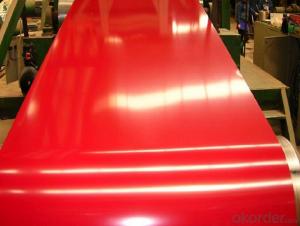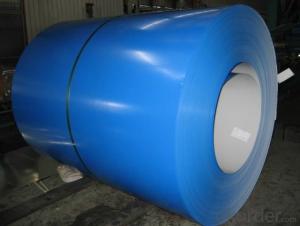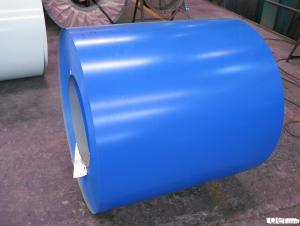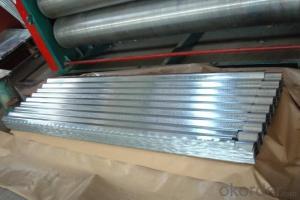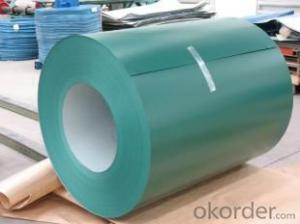ZHONGGUO ZHENGJIANG HANZHOU FUYANG PRE-PAINTED ALUZINC STEEL COIL
- Loading Port:
- Shanghai
- Payment Terms:
- TT OR LC
- Min Order Qty:
- 20 m.t.
- Supply Capability:
- 12000 m.t./month
OKorder Service Pledge
OKorder Financial Service
You Might Also Like
PRE-PAINTED ALUZINC STEEL COIL PRE-PAINTED ALUZINC STEEL SHEET
THICKNESS:0.18mm-1.5mm
WIDTH:900mm-1250mm
COATING MASS:AZ30-AZ180
PAINT:PE、HP、HDP、PVDF、SMP、MATT、PVDF
COLOR:RAL Scale
COIL INNER DIAMETER:508mm/610mm
COIL WEIGHT:3mt-7mt
BASE MATERIAL:Hot-dip Aluzinc Steel
In continuous units in cold rolled steel strip, galvanized steel (electro galvanized and hot dip galvanized) as substrate, after surface pretreatment (degreasing and science processing), using the method of roll coating, coated with a layer or multi-layer liquid coating of plate, after baking and cooling income is the coating steel plate. Because the coating can have a variety of colors, on the habits of the coated steel sheet is called color coating steel plate. Because the coating is carried out before the sheet metal forming, in foreign countries which is called pre coating plate.
Color coated steel sheet is an organic coating coating on the steel surface, it has the advantages of beautiful appearance, bright color, high strength, good corrosion resistance, easy processing molding, but also allows the user to reduce costs, reduce pollution.
From the United States in 1935 to establish the first continuously coated steel line to begin, color coated steel plate has been widely applied, the current color coated plate varieties, about more than 600 kinds, the advantages of color coated sheet and organic polymer and steel plate of the two, which has good colorability, organic polymer molding, corrosion resistance and decorative, and steel plate with high strength and easy processing, can easily be punching cutting, bending, deep drawing processing. Made this makes organic coated steel sheet products have excellent practical, decorative, workability, durability.
- Q: What are the different coil leveling methods used for steel coils?
- There are several coil leveling methods used for steel coils, including roller leveling, stretcher leveling, and tension leveling. Roller leveling involves passing the coil through a series of rollers to remove any curvature and create a flat surface. Stretcher leveling involves stretching the coil in different directions to remove any shape irregularities. Tension leveling applies tension to the coil during the leveling process to eliminate any residual stresses and create a uniformly flat product.
- Q: How are steel coils inspected for formability using forming tests?
- Steel coils are inspected for formability using forming tests to assess their ability to be shaped into desired forms without any defects or failures. These tests are conducted to evaluate the material's mechanical properties and determine its suitability for specific applications. Forming tests involve subjecting the steel coil to various forming operations, such as bending, deep drawing, or stretch forming. The coil is typically cut into specified dimensions and then subjected to these operations using specialized equipment. The key objective is to simulate the actual forming process that the steel will undergo in real-world applications. During the forming tests, several parameters are closely monitored. These include the amount of force or load applied, the rate of deformation, and the resulting strain or deformation experienced by the steel. Additionally, the coil's response to these operations is observed, including any visible defects like cracks, fractures, or surface imperfections. By carefully analyzing the performance of the steel coil during the forming tests, various formability characteristics can be determined. These include the material's resistance to deformation, its ability to withstand strain without failure, and its tendency to exhibit defects under specific forming conditions. The results obtained from these tests provide valuable insights into the suitability of the steel coil for specific forming processes and applications. Moreover, advanced techniques such as digital image correlation and strain analysis may be employed to precisely measure and evaluate the strain distribution across the steel coil's surface. These techniques help identify regions of the coil that experience higher strain and potential failure points. In conclusion, steel coils are inspected for formability using forming tests that simulate the actual forming processes they will undergo. These tests assess various formability characteristics, including the material's resistance to deformation and its propensity for defects. The results obtained from these tests aid in determining the suitability of the steel coil for specific applications and guide the selection of appropriate forming parameters.
- Q: What is the maximum width of galvanized steel strip, please? The galvanized coat is 275, and how long is one coil?
- As far as I know, the galvanized rolls of WISCO are wider in width than other domestic steel mills, and can produce 2080 wide steel coils.
- Q: Is it just because brass is reloadable? But what makes it reloadable? What does brass bring to the equation that the steel cased ammo can't do?
- Brass is slightly softer than annealed steel. Both can be reloaded, once or maybe even twice. But STEEL has a tendency to WORK HARDEN, becoming brittle. Which is why it's used for tools and other applications where work hardening is a plus. It's actually designed to do that. Brass does not work harden, because it is a different sort of metal. That's the main reason.
- Q: How are steel coils welded together?
- Steel coils can be welded together using various methods, depending on the specific requirements and the type of steel being used. One common method is the use of electric resistance welding (ERW), where an electric current is passed through the steel coils to generate heat. This heat melts the edges of the coils, and pressure is applied to join them together. ERW is a quick and cost-effective method for welding steel coils. Another method is high-frequency induction welding (HFIW), which is commonly used for thinner steel coils. In this process, an induction coil is used to generate an alternating magnetic field, which induces an electric current in the steel coils. The resistance of the coils to this electric current generates heat, causing the edges to melt and form a weld. For thicker and heavier steel coils, submerged arc welding (SAW) is often employed. This method involves the use of a granular flux and a continuous electrode, which is fed into the weld area. The flux melts, creating a protective shield for the weld pool, and the electrode melts to form the weld. SAW is a robust and efficient method for welding steel coils. Additionally, laser welding and gas metal arc welding (GMAW) can also be used to weld steel coils. Laser welding offers high precision and speed, while GMAW, also known as MIG welding, uses an electric arc between a consumable wire electrode and the steel coils to create a weld. Regardless of the welding method used, the key factors for successful welding of steel coils are proper preparation of the edges, maintaining the appropriate heat and pressure levels, and ensuring the correct welding technique is employed.
- Q: steel structure
- Disadvantages Of Steel
- Q: I'm in the middle of a remodel and buying appliances. Is there any way to ensure that the stainless steel is the same tone if you get different brands?
- Stainless steel is pretty much stainless steel. The differences in tone you can get is when you get stainless steel look appliances. They tend to be a bit more like a charcoal color than true stainless steel color. When I bought my house, it had a stainless steel GE microwave, dishwasher, and stove, and a Braun stainless steel range hood. When we remodeled last year, we got a Maytag Ice20 stainless steel refrigerator and a Kholer stainless steel sink. They all look fine together.
- Q: I already have the county permits and bank loan, but the foundation hasn't been poured. Is it too late to convert to steel?
- Steel is going to be a whole different world. You will need to go back to square one and get house plans that are drawn for structural steel. First thing you need to do is find a builder that knows how to build with steel and get an idea of the price.
- Q: can u use stainless steel to make a coin? why or why not? answers based on facts plz.
- Stainless steel has been used by some countries to make coins, but it's not an ideal metal. When a coin is struck, a die comes down and strikes the blank with many tons of force (the blank is also sitting on top of another die--one has the image on the obverse (front) of the coin, while the other die has the image of the reverse of the coin). When the die strikes the blank, the force causes the metal in the blank to flow into the recesses of the die. The problem with stainless steel is that it doesn't want to flow into the die. To get an image, either the relief (how high the raised portion of the design will be) has to be very low, and the coin has to have a simple design, or they have to greatly increase the pressure of the strike. This slows the coining press down, and greatly shortens the life of the dies.
- Q: How are steel coils used in the production of industrial tanks?
- Steel coils are used in the production of industrial tanks as they are rolled into cylindrical shapes and welded together to form the tank's body. The coils provide a durable and strong structure, capable of withstanding high pressure and temperature conditions. Additionally, the steel coils can be customized to meet specific size and shape requirements, allowing for efficient and cost-effective tank production.
Send your message to us
ZHONGGUO ZHENGJIANG HANZHOU FUYANG PRE-PAINTED ALUZINC STEEL COIL
- Loading Port:
- Shanghai
- Payment Terms:
- TT OR LC
- Min Order Qty:
- 20 m.t.
- Supply Capability:
- 12000 m.t./month
OKorder Service Pledge
OKorder Financial Service
Similar products
Hot products
Hot Searches
Related keywords
